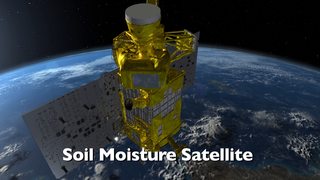Earth
ID: 11743
The microwave radiometer on NASA's Soil Moisture Active Passive (SMAP) satellite was designed and built at NASA's Goddard Space Flight Center. Along with the microwave radar, data from the radiometer will be used to calculate the water content of Earth's soil.
All types of soil emit microwave radiation, but the amount of water changes how much of this energy is emitted. The drier the soil, the more microwave energy; the wetter the soil, the less energy.
But radio frequency interference is a problem, even though the instrument is passively listening in a region of the microwave spectrum where transmission is prohibited. Some of the signals from the surrounding regions leak into the protected "listen-only" band. Goddard engineers developed new hardware and software to search for and cut out the erroneous measurements.
SMAP Radiometer versus Radio Frequency Interference
All types of soil emit microwave radiation, but the amount of water changes how much of this energy is emitted. The drier the soil, the more microwave energy; the wetter the soil, the less energy.
But radio frequency interference is a problem, even though the instrument is passively listening in a region of the microwave spectrum where transmission is prohibited. Some of the signals from the surrounding regions leak into the protected "listen-only" band. Goddard engineers developed new hardware and software to search for and cut out the erroneous measurements.
Related
For More Information
Credits
Jeff Piepmeier (NASA/GSFC): Scientist
Matthew R. Radcliff (USRA): Lead Producer
Matthew R. Radcliff (USRA): Video Editor
Brian Monroe (USRA): Animator
Kate Ramsayer (Telophase): Writer
Rob Andreoli (Advocates in Manpower Management, Inc.): Lead Videographer
John Caldwell (Advocates in Manpower Management, Inc.): Videographer
Swarupa Nune (InuTeq): Narrator
Matthew R. Radcliff (USRA): Lead Producer
Matthew R. Radcliff (USRA): Video Editor
Brian Monroe (USRA): Animator
Kate Ramsayer (Telophase): Writer
Rob Andreoli (Advocates in Manpower Management, Inc.): Lead Videographer
John Caldwell (Advocates in Manpower Management, Inc.): Videographer
Swarupa Nune (InuTeq): Narrator
Please give credit for this item to:
NASA's Goddard Space Flight Center
NASA's Goddard Space Flight Center
Short URL to share this page:
https://svs.gsfc.nasa.gov/11743
This item is part of this series:
Narrated Movies
Goddard TV Tape:
G2015-009 -- SMAP Radiometer
Keywords:
SVS >> HDTV
NASA Science >> Earth
https://svs.gsfc.nasa.gov/11743
This item is part of this series:
Narrated Movies
Goddard TV Tape:
G2015-009 -- SMAP Radiometer
Keywords:
SVS >> HDTV
NASA Science >> Earth












